Walking as Art
Design
Disability Dolls
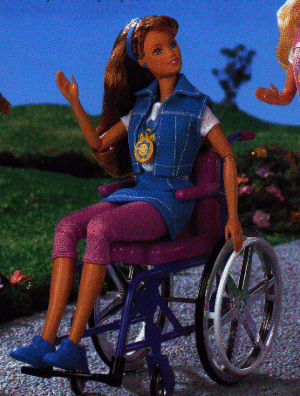 In 1997 toy-maker
Mattel hoped its wheelchair version of Barbie, called Becky, would help
change attitudes and stereotypes about the disabled, and help children
with disabilities build self-esteem. Barbie was introduced in 1959. And
Mattel says it's time her family became more inclusive.
In 1997 toy-maker
Mattel hoped its wheelchair version of Barbie, called Becky, would help
change attitudes and stereotypes about the disabled, and help children
with disabilities build self-esteem. Barbie was introduced in 1959. And
Mattel says it's time her family became more inclusive.
"We for quite some time have had ethnic diversity in Barbie's world,
but we were overdue in terms of really offering a friend who has a disability,"
said Nancy Zwiers, senior vice president for marketing.
 While Mattel is
the largest toy-maker to market a disabled doll, it is not alone. Minnesota-based
Cultural Toys introduced a rag doll in 1995 in a wheelchair. Pleasant Company,
the Wisconsin toy company that makes the American Girl Collection, also
has a wheelchair accessory for its line of dolls. Fisher Price makes a
toy bus with a wheelchair ramp, and Little Tikes has a dollhouse with a
ramp, analysts said.
While Mattel is
the largest toy-maker to market a disabled doll, it is not alone. Minnesota-based
Cultural Toys introduced a rag doll in 1995 in a wheelchair. Pleasant Company,
the Wisconsin toy company that makes the American Girl Collection, also
has a wheelchair accessory for its line of dolls. Fisher Price makes a
toy bus with a wheelchair ramp, and Little Tikes has a dollhouse with a
ramp, analysts said.
Some features of Becky may be changed. For now, Becky's wheelchair won't
fit in most Barbie houses - even the elevator is too small. And unlike
real wheelchairs, Becky's has no seat belt, so she tumbles out easily.
Activists would like to see that changed.
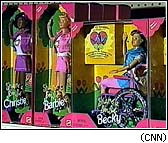 "Everything they
can do to promote the whole accessibility of the world, to children, to
anyone with a disability, we want," said Patricia McGill Smith of National
Parent Network on Disabilities.
"Everything they
can do to promote the whole accessibility of the world, to children, to
anyone with a disability, we want," said Patricia McGill Smith of National
Parent Network on Disabilities.
Disabled groups don't care if Mattel makes money doing the right thing.
They're just happy to see the icon of physical perfection being used to
how that disabilities can be beautiful, too.
More recently, dolls with prostheses, Down
dolls and Chemo Friends (for children undergoing chemotherapy) have
been introduced.
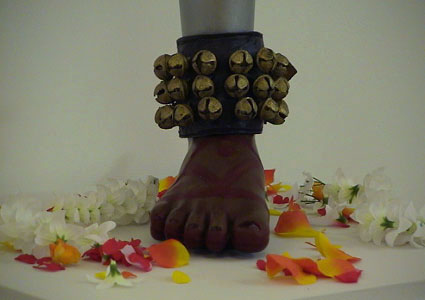 The
Jaipur Foot is used by thousands of people in India and Africa. The Jaipur
Foot is the result of a collaboration between P.K. Sethi, an orthopaedic
surgeon, and Ram Chander Sharma a craftsman
The
Jaipur Foot is used by thousands of people in India and Africa. The Jaipur
Foot is the result of a collaboration between P.K. Sethi, an orthopaedic
surgeon, and Ram Chander Sharma a craftsman
 They
were concerned that people in India who had been fitted with western style
artificial limbs, at great cost to themselves, discarded them so Quickly
They realised that this type of prosthesis is not suitable for floor sitting
barefoot walking Indian people.
They
were concerned that people in India who had been fitted with western style
artificial limbs, at great cost to themselves, discarded them so Quickly
They realised that this type of prosthesis is not suitable for floor sitting
barefoot walking Indian people.
The Jaipur Foot is waterproof, cheap and looks good. It allows the user
to squat and sit cross-legged at floor level. Although the Jaipur Foot
was originally conceived as a solution to a local problem, it is now used
by many thousands of amputees, both on the Indian subcontinent as well
as in landmine countries affected by landmines such as Cambodia and Mozambique.
The photo shows the foot and ankle of the Jaipur leg in close-up. The
foot is dark flesh-coloured, while the leg above is silver. The toe nails
of the foot have been painted red, and the foot itself has been decorated
with red patterns. Around the ankle is a leather ankle bracelet, decorated
with a triple row of bells.
In front of the foot, and around the podium where the Jaipur limb is
displayed, artificial flowers are scattered. Within the exhibition, this
reflects the fact that a video about the Jaipur Limb Campaign is
playing nearby, featuring a dancer who performs Indian classical dance
while wearing a similar limb
Felicity Shillingford: My Left Boot
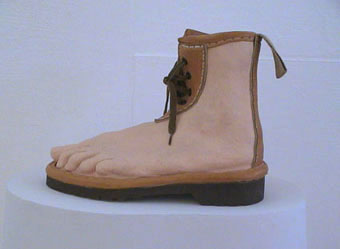
Felicity works in visual art, film and theatre, with actor/director
Garry Robson, producing for their company, 'Fittings Multimedia Arts'.
They make aids and adaptations used by an ever increasing number of people
in their daily lives.
Felicity and Garry first started looking at the design of disability
equipment for their touring exhibition 'Fittings: The Last Freakshow' which
was part exhibition and part performance.
 Paul
is based in Bath and works for a
Paul
is based in Bath and works for a 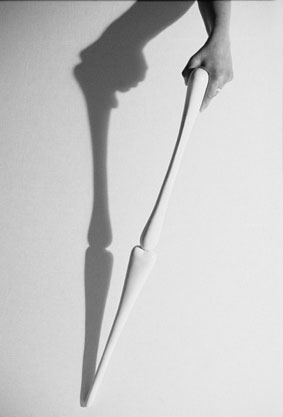 company
that manufactures rickshaws, such as the pollution-free taxi type and custom
built bikes used for street theatre and performance.
company
that manufactures rickshaws, such as the pollution-free taxi type and custom
built bikes used for street theatre and performance.
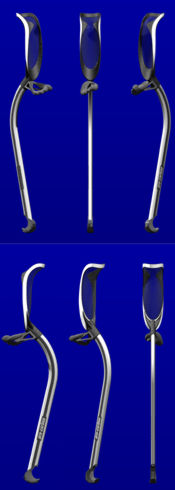 Pro-Carbon
Crutches were inspired by Guy Robinson’s first hand experience of trying
to lead an active life whilst using crutches.
Pro-Carbon
Crutches were inspired by Guy Robinson’s first hand experience of trying
to lead an active life whilst using crutches.
The design places crutches within the world of sport. Pro-Carbon Crutches
not only look good, they also work to reduce sports injuries
that might otherwise be inflicted by conventionally designed crutches.
They are made from silver and grey carbon. Unlike conventional crutches,
they curve backwards rather than being straight. They have silver lower-arm
supports which are made of fabric mesh, and grey hand supports where the
user puts their whole hand through the support and then grips a surface
which has been shaped to fit fingers. The feet are sprung, and resemble
the hooves of animals such as gazelles. Within the exhibition the crutches
are pictured, as only one prototype exists.
Sprung feet absorb impact, whilst the handles support central parts
of the hand that are sensitive to nerve damage. The forearm support is
a fabric mesh, that moulds itself to the forearm, and comfortably distributes
the load.
Guy is continuing his research on Pro-Carbon Crutches and on other prototypes
at the Royal College of Art. His crutches won the care award in ‘Design
for Our Future Selves’ competition, 2002.
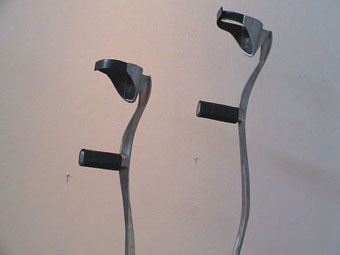 Janie uses callipers
and crutches to walk. In May 2000 Tim and Janie were invited to redesign
a pair of her crutches, placing greater emphasis on individuality. Janie
has always used mass produced crutches, which she describes as “boring
and ugly” and has been frustrated by lack of choice and by the assumption
that “one design will suit everyone”.
Janie uses callipers
and crutches to walk. In May 2000 Tim and Janie were invited to redesign
a pair of her crutches, placing greater emphasis on individuality. Janie
has always used mass produced crutches, which she describes as “boring
and ugly” and has been frustrated by lack of choice and by the assumption
that “one design will suit everyone”.
Tim and Janie wanted the design to reflect Janie’s personality, and
to create crutches that could be used as a form of adornment. Janie wanted
to be able to show off her crutches, and wear them in a night club like
a piece of jewellery. The Couture Crutches are shaped from silver aluminium,
with black rubber handgrips and black shoulder supports. Rather than being
straight, they curve inwards between the shoulder supports and the hand
supports, before curving outwards and then in again at the feet. They are
very elegant.
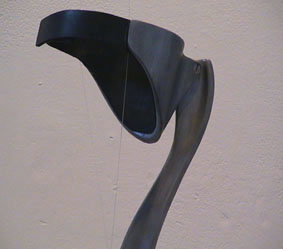
Tim wanted to explore the fluid, twisting shapes found in human bones.
The shapes he created are both bold and engaging, and suggests that the
crutches form an extension of the skeleton. After consulting with Janie
on the final design, Tim cast the crutches into aluminium. Of her finished
crutches Janie says; “they are very sculptural, organic, eye catching,
and most importantly, unique, having a personality of their own, a very
far cry from my NHS crutches!”
Tim Register graduated in Fine Art (Sculpture) from Loughborough University
Janie Spencer is a part time art tutor, and artist based in Leicester.
She graduated in Fine Art from De Montfort University.
Nicola Lane’s installation explores how people see prosthetics both in
the past and currently. In her installation she brings together modern
prosthetics and both historical and contemporary photographs.
Nicola examines the past lives of prosthetic users by creating a sequence
of images, Edwardian photographs from the Science Museum Collection which
have been altered on a computer, to remove the prosthetic limb. The series
of images on the opposite wall show the absent prosthetic limbs. Nicola
makes us think about how the photographer saw these people, how they saw
themselves and how the rest of society saw these individuals.
Nicola arranged for filmmaker Tony Dowmunt to film our visit, and prosthetist
Ozan Altay also came. In the ScienceMu seum’s stores is their ‘Orthopaedic
Collection’, and with an amazing variety of prostheses, including Pre-N.H.S.
bespoke individualised limbs, N.H.S. experiments in electronically powered
limbs for Thalidomide children; 19th Century articulated steel and brass,
and best of all, a collection of
photographs, taken by an Edwardian prosthetist/orthotist of his clients
wearing their appliances, estimated to be in 1906, and all appear (with
one or two exceptions) to have been photographed in the same room, with
a painted backdrop and a patterned floor. In the installation, though,
these aids have been digitally removed from the photographs, leaving behind
their shape in grey. Another series of seven posters shows the aids themselves,
pictured against a grey background.
The second part of the installation consists of a series of four poster-sized
photographs. Each shows an historical artificial limb, made between the
eighteenth and early twentieth century, photographed against a brightly
coloured background. The silicon leg covers used in the installation are
designed to look as real as science allows. Again Nicola is concerned about
the gap between appearances and how things really are. These leg covers
are just for appearance, and do not function as real prosthetics.
Nicola does not believe that cosmesis, the appearance of prosthetics
should be separated from the function of a prosthetic. She believes that
alternatives such as the Jaipur foot are more truly inclusive for the user.
They represent function as cosmesis.
By emphasising function, comfort and ease of use, Nicola claims that
cosmesis should be about how the user feels about their prosthetic. Not
how the viewer feels looking at it. By separating the prosthetics from
the figures, Nicola is inviting the viewer to imagine what prosthetic they
would like to wear.
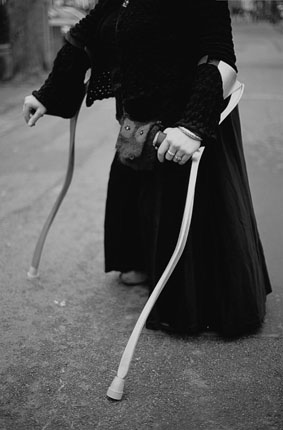 Aesthetics
and design never seem to be where disabled people want them in the list
of priorities. In architecture and building design, aesthetics so often
override function that access usually gets created as an afterthought,
bolted on against the disapproval of the style-driven architects. Disabled
people in public buildings curse and battle against slippery floors, cavernous
acoustics, weighty doors and perspex signposts – designed for aesthetics,
not for function.
Aesthetics
and design never seem to be where disabled people want them in the list
of priorities. In architecture and building design, aesthetics so often
override function that access usually gets created as an afterthought,
bolted on against the disapproval of the style-driven architects. Disabled
people in public buildings curse and battle against slippery floors, cavernous
acoustics, weighty doors and perspex signposts – designed for aesthetics,
not for function.
Yet when it comes to the everyday items which disabled people must have,
their clothes, homeware and mobility aids, the exact opposite seems to
apply. We are provided with items that can be easily mass-produced, cleaned
or stacked in a cupboard by a nurse or carer, and not what we would choose
to wear or carry.
Aluminium, rubber and a curious bakelite plastic in grey or flesh-tones
are the materials we get handed. The welter of colour, choice and subliminal
pressure applied to the consumer in every other case passes us by.
The message we get is clear – design is not for us. Concepts like opinion,
taste, choice, pleasure and excitement are absent in the provision made
for what we need. A direct opposition is set up between the ideas of "need"
and "want". It is a moral lesson – beggars can’t be choosers, and disabled
people are very evidently cast in the role of beggar.
It wasn’t always so. Social history collections in museums show us that
the moneyed disabled person used to be able to commission craftworks that
served their needs – exquisitely carved wheeled chairs, the candy-twists
of Venetian glass walking canes, hand-embroidered waistcoats which disguised
the bodies of rich men with spinal curvature. Even if you weren’t rich,
before mass-production became ordinary, it would not have been so difficult
to make a jacket that fitted
short arms, or a missing limb. Your one pair of boots would have been
made for you, your chair the height you needed to reach the
table.
Disabled people were the cast-offs after standardisation in the 20th
century, when difference became bad, and average a word of
approval. Manual crafts and personalisation were marginalised in favour
of the ‘one-size-fits-all’ lie. Ergonomics invented an
acceptable range of difference around the design of cars, cookers and
school desks, and within which short, fat or one-legged people
didn’t fit. It’s considered shocking in this context to claim that
normality is, in fact, an exception – that most of us are abnormal.
Not far beneath the surface of each collaboration in this exhibition
lie the ghosts of a more responsive past – 500 workmen bending
over wooden benches in a limb-fitting centre, the secret clay pigments
of the Arizona desert which created flesh-toned prostheses,
walking sticks which contained brandy for tedious social events or
poisoned darts for your enemies. The artists, makers and
designers involved in adorn, equip have come to see disabled people
as personalities and tried to serve them in a way which
creates not just comfort but the thrill of ownership, fun and status.
What’s new for the 21st Century is the acknowledgment of
feelings – of fear and challenge, insecurity and isolation – which
can be addressed with accessories and aids which are desirable
and worth showing off. Their solutions might not fit in every household
– but that’s part of the point. What they offer is an answer
which suits individuals with specific combinations of need, choice,
want and taste – because, guess what? All of these consumer
desires exist in every disabled person who wants to adorn or equip
themselves.
Go Go
Gadget Wheelchair: Fit, Form and Desire
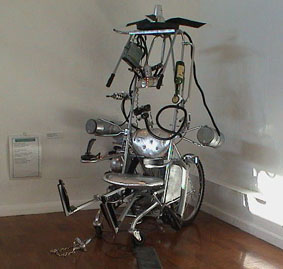 The
Go Go Gadget Wheelchair is silver and imposing and
The
Go Go Gadget Wheelchair is silver and imposing and
cannot be ignored: its user will always be visible, however hard passers-by
try to ignore them - particularly given the flashing hazard
lights. And if onlookers are abusive, there is always the boxing glove
on a
spring, or in extreme cases, the rocket which is mounted on the side.
Or
the user can ignore them and choose instead to turn on the radio, use
the
camera or simply have a drink of whisky.
Mountain bike wheels state that the user intends to go everywhere,
without restraint, and a helicopter-like propeller shows how this will
be
managed in the face of obstructions like steps and kerbs. The speed
of
the chair is unhampered by social workers’ fears that disabled people
will run riot and cause accidents if we travel at more than five miles
an
hour: aircraft engines are mounted on each side of the chair, while
a
platform at the back allows a companion to ride along when they are
unable to keep up on foot. A grappling hook can be thrown out
anchor-like to stop the chair, or to retrieve objects that are otherwise
inaccessible.
And the user of such a chair can only be a superhero - not invisible
and
denied full civil and human rights, “bravely” negotiating a disabling
world, as wheelchair users in this country are today. In real life,
though,
disabled people do not want to seen as heroic - just as being “normal”,
with it being normal to include us fully in every part of life, and
to create
an environment which allows for this.
How can a wheelchair be an object of desire? It is more commonly portrayed
as an object of horror and disgust, and the need to use it as a tragedy.
We all recognise the newly disabled character in film and television -
generally played by a non-disabled actor - who detests their wheelchair
and wants nothing more than to
get out of it, sometimes choosing to die instead if this is not a possibility.
The language that we use to refer to wheelchair users is equally
unhelpful. Non-disabled people talk of someone “being in a wheelchair
for 15 years” - as if wheelchair users do not leave their chairs every
day
to sleep, bathe, use the toilet, drive, or just to join the rest of
the family
on the settee in front of the television in the evening. And non-disabled
people frequently refer to full-time wheelchair users (one in twenty
of all
wheelchair users) as being “confined” to their wheelchairs, as if the
chair
is an object of imprisonment rather than of liberation.
 Of
course, many of the wheelchairs supplied to disabled people by the
Of
course, many of the wheelchairs supplied to disabled people by the
State in the form of social services or the NHS are disabling in
themselves: these chairs are often badly designed, ugly, uncomfortable,
and difficult or impossible to use independently. My own NHS
“self-propelling” wheelchair was difficult for anyone to lift into
a
car, increased my pain levels because it provided no proper spinal
support for me, and was in fact to heavy to propel independently. Who
indeed would welcome one of these into their lives?
But when a wheelchair does fit us, when its form does suit us, when
its
design does meet fully with our desires, then it is the most liberating,
desirable means of transport for people with mobility impairments of
every kind. Suddenly we can sit comfortably and move wherever we
wish for as long as we wish at the touch of a button or the flick of
a
wheel: we are free.
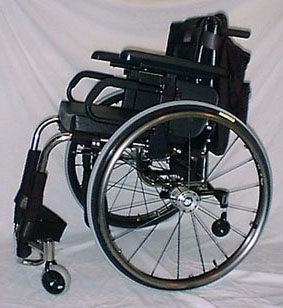 The
new self-propelling wheelchair, made by RGK and supplied by the Wheelchair
Warehouse, is a genuine object of desire. Manufactured largely from titanium
and leather, it was custom-made. But its purchase was made possible only
by the Government’s Access to Work Scheme - desirable wheelchairs which
empower our independence are expensive, while disabled people have the
lowest incomes of anyone in the country. Despite the language of “social
inclusion”, desirable wheelchairs are not considered to be necessary for
us to live independently, only to work.
The
new self-propelling wheelchair, made by RGK and supplied by the Wheelchair
Warehouse, is a genuine object of desire. Manufactured largely from titanium
and leather, it was custom-made. But its purchase was made possible only
by the Government’s Access to Work Scheme - desirable wheelchairs which
empower our independence are expensive, while disabled people have the
lowest incomes of anyone in the country. Despite the language of “social
inclusion”, desirable wheelchairs are not considered to be necessary for
us to live independently, only to work.
Equally, the popular image of the wheelchair prevails, and as a result,
many people who would benefit from using a wheelchair either refuse,
or are refused permission, to do so. The goal is to appear “normal”
-
without impairments - as if having a mobility impairment is not normal,
and as if we will not all have impairments of some kind over the course
of our lifetimes. Thus people who have great difficulty in walking
are still
denied or deny themselves access to wheelchairs, and have far narrower,
harder lives as a result.
This attitude is propagated at the highest levels of our society. The
Pope
and the Queen Mother, both old enough to know better, refused to be
seen in public using wheelchairs, preferring to be be viewed as immobile
and dependent. Perhaps it is unsurprising, then, that so many other
older
people within our society are leading restricted and difficult lives
rather
than use a wheelchair. Meanwhile physiotherapists continue to teach
disabled people that wheelchair use is a sign of failure, to be avoided
if at
all possible even if the alternative is pain and immobility.
The irony, of course, is that many non-disabled people in the United
Kingdom rarely walk at all - they sit down and drive their children
to
school; they sit down and drive to the shops; they sit down and drive
to
work; they sit down and drive to see their friends - even when all
of
these activities take place within five miles of their homes. And then
they
come home and sit down in front of the television until it is time
to go to
bed. That would have been unthinkable in this country during the first
half of the twentieth century, and remains unthinkable in many countries
worldwide today.
And yet, despite the billions of pounds which are spent on roads to
facilitate the use of private cars, and the massive changes to the
environment that this causes, no one questions this as being “normal”.
It
is both “normal” to walk, and at the same time it is “normal” for those
who can walk to choose NOT to walk. Indeed, it is desirable not to
walk
if you CAN walk easily: a car signifies status and power; while walking
signifies poverty.
If someone needs to use a wheelchair in order to live their life as
fully as
possible, though, everything changes. It is “normal” to build roads,
and
then to install speed humps, but it is not regarded as “normal” to
create
regular dropped kerbs to allow wheelchair users, parents with buggies
etc to cross those roads easily. It is “normal” to build steps rather
than
ramps; it is not regarded as “normal” to install lifts instead of or
as well
as staircases. In fact, it is “normal” to make the built environment
difficult or impossible for all of us to access at some point in our
lives, as
if we only deserve to participate fully in society when we can walk
(even
if we normally choose to drive instead).
Convertible High Heels
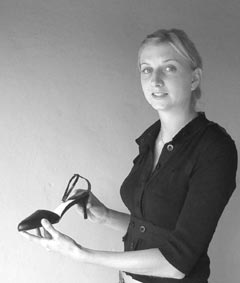
High heels are the only acceptable form of shoe for females on a formal
occasion, and are almost mandatory in a business power dressing, yet they
are very uncomfortable and casue long term health issues. How many times
have you seen women walking to work in sensible shoees carrying high heels
in their handbag? A new design for adjustable high heels could solve the
problem. This shoe solution converts a high 7 cm heel to a low 3 cm heel
with one simple twist on/off action.
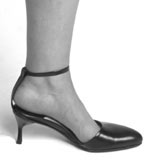

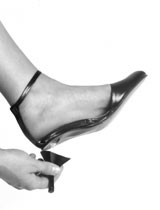
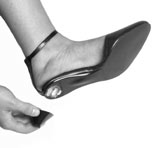

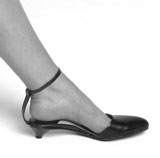
North Sydney UTS student Sophie Cox's idea came to her when she wrote
a Research Dissertation Paper for her university of technology Studies
in 2003 on the subject of the physical effects of high heels on women.
The concept of the CONVERTIBLES (Adjustable High Heels) came from researching
the paper.
“I was horrified when I looked into the physical problems which
high heels cause in women. In many ways, it is a modern western form of
the Japanese foot-binding, where a social or cultural tradition creates
long term health problems.”
“It’s unfortunate, but high-heeled footwear creates prolonged
problems for wearer’s feet, back and knees.
“On the other hand, high heels now play a very complex role in modern
society and have become the only shoe accepted for women on formal occasions
and the shoe of choice for women in business when they’re in ‘power dressing’
mode.”
“There’s no question that when you put on a set of heels, you feel great.
It’s a psychological thing, but when you’re working long hours in an office,
you need comfortable attire. So sometimes, say, several times a day, you
want your full high heels, and the rest of the time you want comfortable
shoes.
The design of the heels flowed from there but it’s always been a subject
close to Sophie’s heart. As I went through school, I was never quite sure
where I would end up – I wanted at different times to go into fashion,
sculpture and I’ve always had a thing about shoes, and when it came time
to specialise, I thought that the ralm of industrial design gave me the
opportunity to express it all.
Bernard Rudofsky: Unfashionable Human Body
Trousers shape the leg so it appears as a tubular appendage. Author Bernard
Rudofsky writes this about the trouser: "The trinity of thigh, knee and
calf, each marvelously molded and replete with eye and sex appeal, is stuck
into a cylinder . . . but fails to do justice to a live one."


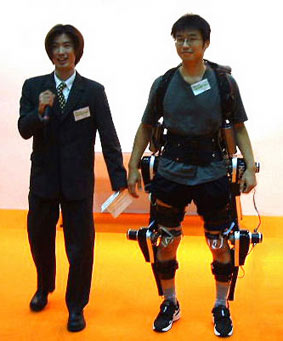
The Power Assist Suit was developed at Kanagawa to aid nurses in lifting
immobile patients. Electronic sensors monitor the user’s muscles and trigger
the hydraulically operated suit to boost strength by more than 50%. The
aging world population is seen as an affluent target market for carer and
helper robotic applications.
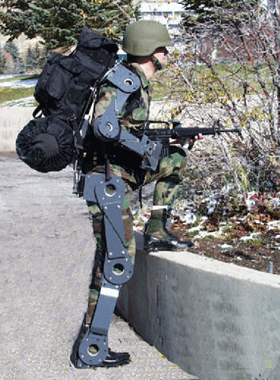

In a push to turn the science fiction of exoskeletons - like the one used
by Sigourney Weaver in
Aliens - into a military reality and deliver the advantages of such technology
to soldiers in combat
environments, the US Defense Advanced Research Projects Agency (DARPA),
is funding a
US$50 million project known as "Exoskeletons
for Human Performance Augmentation". The
scope of the program includes the development of actively controlled exoskeletons
that not only
increase strength and speed, but enable larger weapons to be carried, provide
a higher level of
protection from enemy fire or chemical attack, allow wearers to stay active
longer and carry
more food, ammunition and field supplies. Exoskeletons may eventually even
be programmed to
bring injured soldiers back to base by themselves. Systems will range from
un-powered
mechanical devices that assist a particular aspect of human function to
fully-mechanised
exoskeletons relying on chemical or hydrocarbon fuels for totally independent
operation by
soldiers in the field.
Several different projects under the DARPA umbrella are underway including
SARCOS
Research Corporation's Wearable Energetically Autonomous Robots (WEAR).
Designed for
on-foot combat, WEAR will include a base unit configured like legs, torso
and arms that mimic
human movement using complex kinematic systems and contain energy storage,
power systems,
actuators and everything needed for an autonomous wearable system. ASP's
(Application-Specific Packages) will provide additional protection against
specific threats like
radiation and biological agents or give expanded functionality for communications,
surveillance or
night operations. SARCOS is on track to have a legs only version of the
exoskeleton ready for
trial by 2003 and a working full-body prototype is expected around 2005.


The problems of actuation, power supply and energy storage are being tacked
on several fronts
with M-DOT Aerospace working on a META (Mesoscopic Turboalternator) engine
capable of
acting as a viable electric power source for human exoskeletons and Quoin
International
developing a unique power supply and actuation system for anthropomorphic
exoskeletons using
hydrocarbon fuels and high-pressure pneumatic systems to mimic human movement.

The Berkeley Lower Extremity Exoskeleton, or Bleex, is part of a US
defence project designed to be used mainly by infantry soldiers.
The device consists of a pair of mechanical metal leg braces including
a power unit and a backpack-like frame.
More than 40 sensors and hydraulic mechanisms calculate how to distribute
weight just like the nervous system.
These help minimise the load for the wearer.
A large rucksack carried on the back contains an engine, control system
and space for a payload.
"There is no joystick, no keyboard, no push button to drive the device,"
said Homayoon Kazerooni, director of the Robotics and Human Engineering
Laboratory at the University of California.
The Bleex exoskeleton has a small, purpose-built combustion engine built
into it. On a full tank the system should be able to run for up to two
hours.
The device's leg braces are attached to a modified pair of army boots
and connected to the user's legs.
In the lab, subjects have walked around in the 45kg (100lbs) exoskeleton
plus a 31.5kg (70lbs) backpack and reported that it felt like they were
carrying little over 2kg (5lbs).
"The design of this exoskeleton really benefits from human intellect
and the strength of the machine," said Dr Kazerooni.
The project has been funded by the US Defense Advanced Research Projects
Agency (Darpa).
 1
kW/leg Servo Assist
1
kW/leg Servo Assist
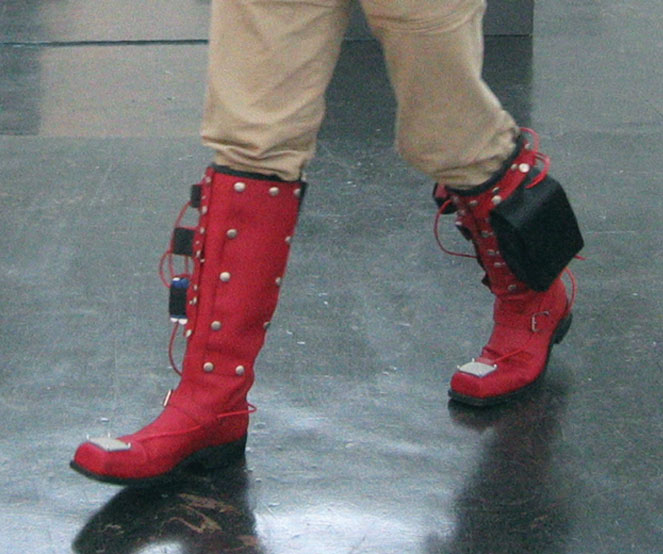
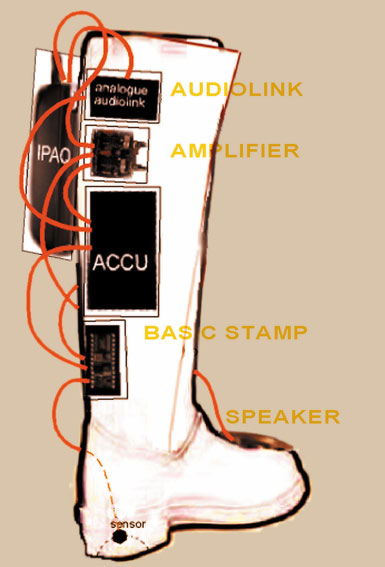
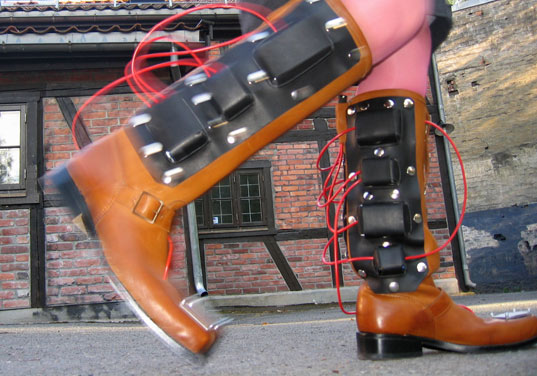
Sitting somewhere between performance and experiential art, Seven Mile
Boots are interactive shoes with audio. One can wear the boots, and walk
around simultaneousy in the physical world and in the literal world of
the internet. By walking in the physical world one may suddenly encounter
a group of people chatting in real time in the virtual world. The chats
are heard as a spoken text coming from the boots. The concept is that whenever
you wear the boots, the physical and the virtual worlds will merge together.
The seven-mile-boots are intended as an interface to move within this text-based
non-space of the chatrooms. The boots have two different modes; walking
through the net and standing/ listening/ observing the chat-activity.
When walking, the boots seek a new selection of channels from the net.
The boots contain all the necessary technology and the user does not control
or influence the experience - there's a computer with wireless network,
sensors, amplifiers and loudspeakers. The boots are ready to function in
any location with an open wireless network, though poresumably you'll need
some sort of filter for public places where the chat room contents may
not be suitable to be read aloud by your boots in a public place. The boots
are intended to shift the viewpoint from the physical to the conceptual,
focusing on the ordinary everyday activities and desires of people and
offer a perspective into the processes, which are an inherent part of our
current lifestyle.
When the user is wearing the seven-mile-boots and standing still s/he
can listen several chat rooms simultaneously becoming a super-voyeur, and
able to search in several places and observe various situations simultaneously
in the net. After putting on the boots they start looking for active chat
channels. When the user walks around s/he can locate a chat activity through
audio. S/he will hear himself passing through a group of chatters or s/he
can decide to stop for closer observation. The boots log into the chat
rooms automatically under the name of "sevenmileboots".
Maxwell Smart's Shoe Phone (Get Smart)
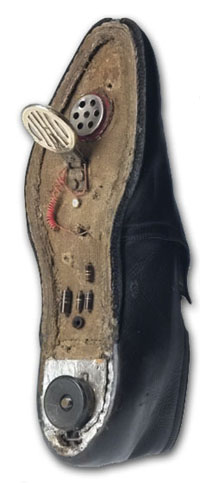
Operator: "What number are you calling?"
Smart: "I'm calling Control, Operator…"
Operator: "You have dialed incorrectly. Give
me your name and address and your dime will
be refunded."
Smart: "Operator, I'm calling from my shoe!"
Operator: "What is the number of your shoe?"
Smart: "It's an unlisted shoe, Operator!"
Maxwell Smart, Agent 86 of Control, cleverly housed a telephone in his
shoe. As used for five seasons by Don Adams in the Emmy-winning comedy
series, the Shoe Phone has earned a permanent place in our memories, our
hearts, and especially our funny bones, as a classic icon of popular culture.
CIA Spy Shoe with Heel Transmitter
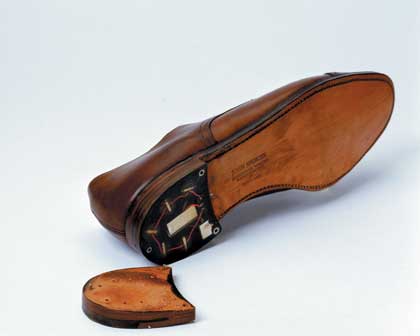 Looking like a quirky
prop from Get Smart, the 1960's KGB issue Spy Shoe with a radio transmitter
concealed in the heel was used to monitor secret conversations. The shoe's
transmitter, microphone, and batteries were imbedded in the heel of a target's
shoe. A maid or valet with access to the individual's clothing would be
given the job of planting the rigged shoes and activating the transmitter
by pulling out a white pin from the heel. The target would then become
a walking radio station, transmitting all conversations to a nearby monitoring
post.
Looking like a quirky
prop from Get Smart, the 1960's KGB issue Spy Shoe with a radio transmitter
concealed in the heel was used to monitor secret conversations. The shoe's
transmitter, microphone, and batteries were imbedded in the heel of a target's
shoe. A maid or valet with access to the individual's clothing would be
given the job of planting the rigged shoes and activating the transmitter
by pulling out a white pin from the heel. The target would then become
a walking radio station, transmitting all conversations to a nearby monitoring
post.
Escape Boots
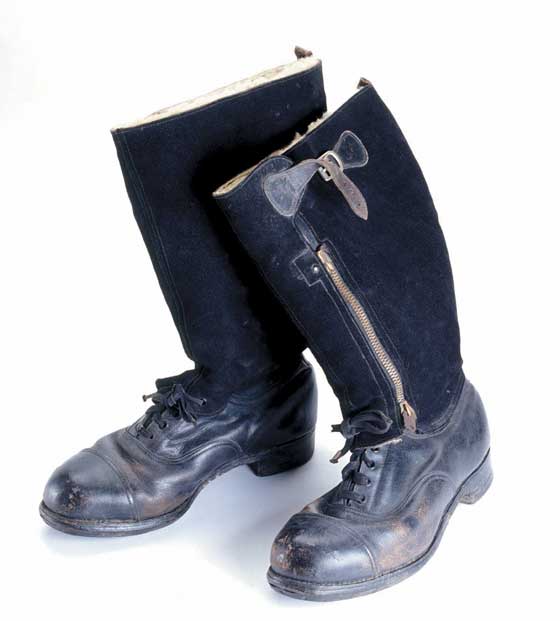
These English MI9 issue boots were designed for British pilots trying
to escape detection in enemy territory. A small pen-knife concealed in
the boots was used to cut off the tops so that they looked like civilian
walking shoes rather than easily recognisable "flying boots".
Wenzhou, Shoe and Sock-making Capital of China
 As far back
as the Southern Song Dynasty
As far back
as the Southern Song Dynasty
(1127-1279) there were professional shoe-makers in
Lucheng. Wenzhou is where China's first pigskin,
sulfide leather, and molded leather shoes were made.
Among China's six most famous brands of shoes, three
-- Kangnai, Dongyi and Jierda -- are from Lucheng. As
Wenzhou's pillar industry, the shoe-making sector
encompasses over 4,000 enterprises, yielding an annual
output value of 30 billion yuan, and an export value of 6
billion yuan. Wenzhou indubitably leads China's
shoe-making industry.
On Woqi Mountain by the Oujiang River in Wenzhou stands the city's landmark
building --
China Shoe Capital Culture Museum. The first modern shoe museum in the
country, it houses
more than 2,000 exhibits dating from Neolithic to modern times, and includes
many rare items.
The Shoe Capital Industrial Park, currently under construction, is the
future site of Wenzhou's
largest and most well reputed shoe-making enterprises. Occupying an area
of 6.5 square
kilometers, scientific research, trading, information exchange and manufacture
are to be
conducted at this large shoe production base. It is expected to become
the world's largest
shoe-making center.
As the local leather-shoe-making sector flagship, Kangnai has set up 33
outlets in Europe and
North America, and has registered its trademark in 36 countries and regions.
In order to make
itself an international brand Kangnai employs Italian shoe designers.
Pop culture seems to share this shoe fetish; rappers in particular are
calling a lot of attention to
their footwear. Reebok has recruited all the top urban icons as pitchmen:
Jay-Z has the S.
Carter line; 50 Cent has the G-Unit; Pharrell Williams has just released
the Ice Cream collection.
Nelly has a song solely dedicated to hyping Nike's Air Force Ones. There's
even been a rash of
books published on the subject, including DJ Bobbito's Where'd You Get
Those? New York City's
Sneaker Culture: 1960-1987 (Powerhouse Books, 2003). How did gym shoes
get to be so huge?
Where is this widespread obsession with sneakers coming from?
At the Vancouver International Hip-Hop Film Festival this September, one
documentary,
Sneakers, offered some insight. Netherlands director Femke Wolting tracked
the progression of
the sneaker from functional sportswear to a marker of cultural identity.
He interviewed shoe
historian Scoop Jackson, who believes that American ghettos inspired the
global sneaker
explosion. Young black men in the inner city experienced low employment
rates and had little
spending money, Jackson argues. With no jobs to dress up for and limited
funds, they made
cheap basketball shoes like Converse the footwear of choice.
As time went on, running shoes became a status symbol. Sporting brand-new
designer kicks
demonstrated that one was moving up; conspicuous consumerism was a way
of asserting
identity in the face of harsh economic and social realities. When hip-hop
artists exploded onto
the international stage, they transformed sneakers into high fashion. The
track "My Adidas", for
instance, saw Run-DMC popularize 'hood style and skyrocket sales for the
shell-toed shoe. When
Michael Jordan teamed up with Nike for the Air Jordan, sneaker culture
hit the mainstream in a
big way. The shoe was so highly anticipated that it had a release date,
just like an album.
Nowadays, sneaker enthusiasts all over the world have massive collections
that keep eBay in
business. A select group of Vancouver hip-hop heads has always been up
on kicks, but the
sneaker-freak culture here is growing exponentially, and a new store has
recently opened in
Gastown to serve this demographic.
Livestock (239 Abbott Street) is the brainchild of Garret
Louie (aka G-Man), urban music
promoter, DJ, and long-time sneaker collector. Louie's day job is co-owner
of Timebomb Trading,
a skateboard, snowboard, and streetwear distribution company. Over the
past 15 years, he has
travelled extensively for work, hitting major sneaker spots in Japan, New
York, Los Angeles, and
London, and picking up hundreds of pairs along the way. Louie decided this
year that Van City
was ready for a serious sneaker boutique. He teamed up with Kenta Kimura,
Garry Bone, and
Robert Rizk to open Livestock, which is one of a handful of stores in North
America that carries
such desirable, collectible sneakers.
Deadstock is a term for shoes that have never been worn and
that are still in the box with their
original laces. These shoes are the most valuable to collectors. Louie
and company decided that
they wanted to emphasize enjoyment. "We said, 'Screw keeping them in the
box, even though
they could be worth $500 down the road,' " he explains, interviewed recently
at the shop. "We
said, 'Let's call it Livestock. Let's wear the shoes: skateboard in them,
b-boy in them, wear them
to the club.' "
The store is beautifully designed, with a minimalist modern vibe. Dozens
of carefully selected
shoes line the walls. (Prices range from $60 to $300.) Louie walks me around,
pointing out
favourites and imparting design and history tips. Many of the shoes are
packaged in bundles: a
baseball pack has soft glove leather; a World Cup soccer pack features
the colours of national
flags; a Navigation pack has maps of the big sneaker collecting cities
laser cut onto leather
panels. One of the hot lines right now is Japanese designer Nigo's Bathing
Ape brand.
The store balances its stock between rare finds and more traditional fare.
It focuses on
expanding the culture through sponsoring hip-hop shows and art events,
and encouraging
budding sneaker heads. "We don't want to be that shop that cops an attitude
that's too cool for
school," Louie says. "Everyone was starting in this culture at one time.
We're totally cool with
educating people."
 While Mattel is
the largest toy-maker to market a disabled doll, it is not alone. Minnesota-based
Cultural Toys introduced a rag doll in 1995 in a wheelchair. Pleasant Company,
the Wisconsin toy company that makes the American Girl Collection, also
has a wheelchair accessory for its line of dolls. Fisher Price makes a
toy bus with a wheelchair ramp, and Little Tikes has a dollhouse with a
ramp, analysts said.
While Mattel is
the largest toy-maker to market a disabled doll, it is not alone. Minnesota-based
Cultural Toys introduced a rag doll in 1995 in a wheelchair. Pleasant Company,
the Wisconsin toy company that makes the American Girl Collection, also
has a wheelchair accessory for its line of dolls. Fisher Price makes a
toy bus with a wheelchair ramp, and Little Tikes has a dollhouse with a
ramp, analysts said.
 In 1997 toy-maker
Mattel hoped its wheelchair version of Barbie, called Becky, would help
change attitudes and stereotypes about the disabled, and help children
with disabilities build self-esteem. Barbie was introduced in 1959. And
Mattel says it's time her family became more inclusive.
In 1997 toy-maker
Mattel hoped its wheelchair version of Barbie, called Becky, would help
change attitudes and stereotypes about the disabled, and help children
with disabilities build self-esteem. Barbie was introduced in 1959. And
Mattel says it's time her family became more inclusive.
 "Everything they
can do to promote the whole accessibility of the world, to children, to
anyone with a disability, we want," said Patricia McGill Smith of National
Parent Network on Disabilities.
"Everything they
can do to promote the whole accessibility of the world, to children, to
anyone with a disability, we want," said Patricia McGill Smith of National
Parent Network on Disabilities.
 The
Jaipur Foot is used by thousands of people in India and Africa. The Jaipur
Foot is the result of a collaboration between P.K. Sethi, an orthopaedic
surgeon, and Ram Chander Sharma a craftsman
The
Jaipur Foot is used by thousands of people in India and Africa. The Jaipur
Foot is the result of a collaboration between P.K. Sethi, an orthopaedic
surgeon, and Ram Chander Sharma a craftsman
 They
were concerned that people in India who had been fitted with western style
artificial limbs, at great cost to themselves, discarded them so Quickly
They realised that this type of prosthesis is not suitable for floor sitting
barefoot walking Indian people.
They
were concerned that people in India who had been fitted with western style
artificial limbs, at great cost to themselves, discarded them so Quickly
They realised that this type of prosthesis is not suitable for floor sitting
barefoot walking Indian people.

 Paul
is based in Bath and works for a
Paul
is based in Bath and works for a  company
that manufactures rickshaws, such as the pollution-free taxi type and custom
built bikes used for street theatre and performance.
company
that manufactures rickshaws, such as the pollution-free taxi type and custom
built bikes used for street theatre and performance.
 Pro-Carbon
Crutches were inspired by Guy Robinson’s first hand experience of trying
to lead an active life whilst using crutches.
Pro-Carbon
Crutches were inspired by Guy Robinson’s first hand experience of trying
to lead an active life whilst using crutches.
 Janie uses callipers
and crutches to walk. In May 2000 Tim and Janie were invited to redesign
a pair of her crutches, placing greater emphasis on individuality. Janie
has always used mass produced crutches, which she describes as “boring
and ugly” and has been frustrated by lack of choice and by the assumption
that “one design will suit everyone”.
Janie uses callipers
and crutches to walk. In May 2000 Tim and Janie were invited to redesign
a pair of her crutches, placing greater emphasis on individuality. Janie
has always used mass produced crutches, which she describes as “boring
and ugly” and has been frustrated by lack of choice and by the assumption
that “one design will suit everyone”.



















 Aesthetics
and design never seem to be where disabled people want them in the list
of priorities. In architecture and building design, aesthetics so often
override function that access usually gets created as an afterthought,
bolted on against the disapproval of the style-driven architects. Disabled
people in public buildings curse and battle against slippery floors, cavernous
acoustics, weighty doors and perspex signposts – designed for aesthetics,
not for function.
Aesthetics
and design never seem to be where disabled people want them in the list
of priorities. In architecture and building design, aesthetics so often
override function that access usually gets created as an afterthought,
bolted on against the disapproval of the style-driven architects. Disabled
people in public buildings curse and battle against slippery floors, cavernous
acoustics, weighty doors and perspex signposts – designed for aesthetics,
not for function.
 The
Go Go Gadget Wheelchair is silver and imposing and
The
Go Go Gadget Wheelchair is silver and imposing and
 Of
course, many of the wheelchairs supplied to disabled people by the
Of
course, many of the wheelchairs supplied to disabled people by the
 The
new self-propelling wheelchair, made by RGK and supplied by the Wheelchair
Warehouse, is a genuine object of desire. Manufactured largely from titanium
and leather, it was custom-made. But its purchase was made possible only
by the Government’s Access to Work Scheme - desirable wheelchairs which
empower our independence are expensive, while disabled people have the
lowest incomes of anyone in the country. Despite the language of “social
inclusion”, desirable wheelchairs are not considered to be necessary for
us to live independently, only to work.
The
new self-propelling wheelchair, made by RGK and supplied by the Wheelchair
Warehouse, is a genuine object of desire. Manufactured largely from titanium
and leather, it was custom-made. But its purchase was made possible only
by the Government’s Access to Work Scheme - desirable wheelchairs which
empower our independence are expensive, while disabled people have the
lowest incomes of anyone in the country. Despite the language of “social
inclusion”, desirable wheelchairs are not considered to be necessary for
us to live independently, only to work.















 SpringWalker
SpringWalker 1
kW/leg Servo Assist
1
kW/leg Servo Assist




 Looking like a quirky
prop from Get Smart, the 1960's KGB issue Spy Shoe with a radio transmitter
concealed in the heel was used to monitor secret conversations. The shoe's
transmitter, microphone, and batteries were imbedded in the heel of a target's
shoe. A maid or valet with access to the individual's clothing would be
given the job of planting the rigged shoes and activating the transmitter
by pulling out a white pin from the heel. The target would then become
a walking radio station, transmitting all conversations to a nearby monitoring
post.
Looking like a quirky
prop from Get Smart, the 1960's KGB issue Spy Shoe with a radio transmitter
concealed in the heel was used to monitor secret conversations. The shoe's
transmitter, microphone, and batteries were imbedded in the heel of a target's
shoe. A maid or valet with access to the individual's clothing would be
given the job of planting the rigged shoes and activating the transmitter
by pulling out a white pin from the heel. The target would then become
a walking radio station, transmitting all conversations to a nearby monitoring
post.

 As far back
as the Southern Song Dynasty
As far back
as the Southern Song Dynasty
